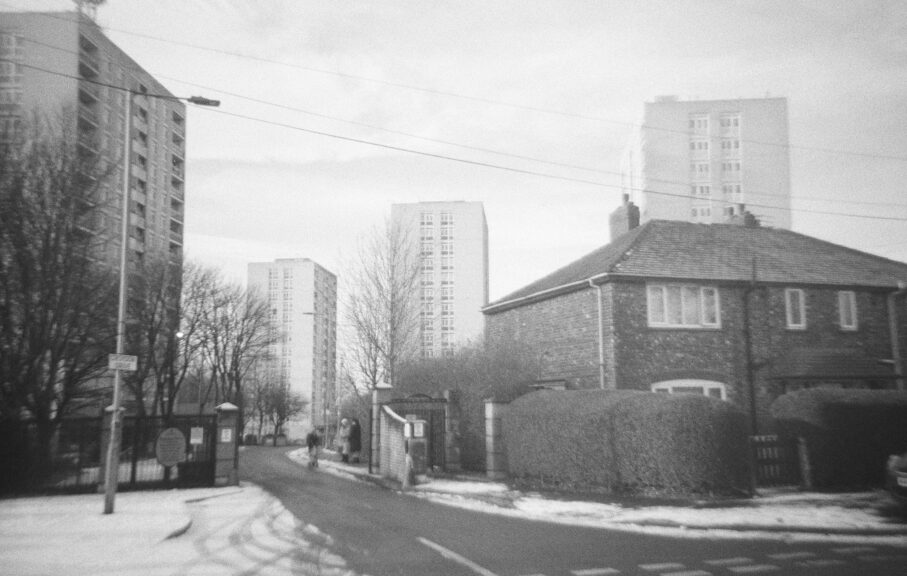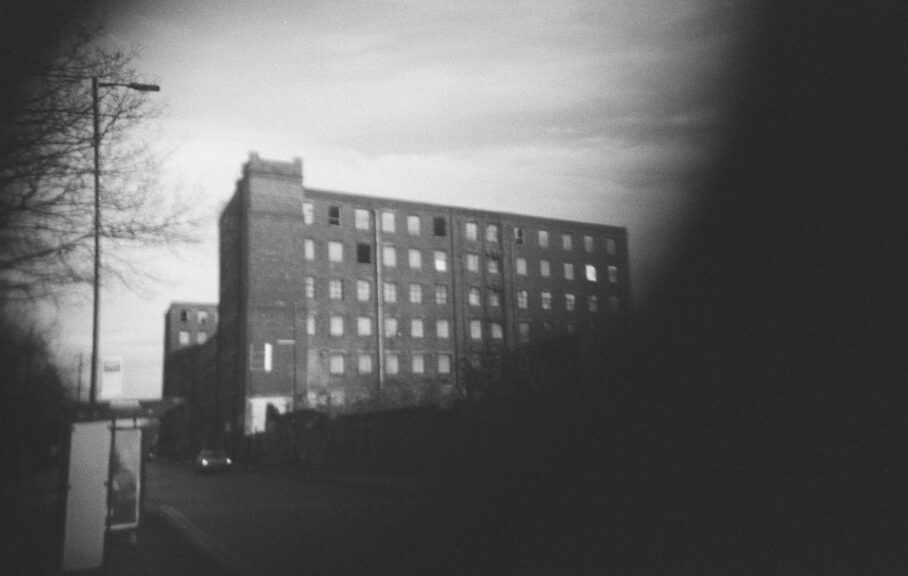The book takes as its subject certain axes which physically dissect the city along economic, social and political lines. So, in order to discuss the book, we decided to take it for a walk, physically tracing its argument from the city’s outskirts where there is evidence of a bygone era of ambitious social housing, to the city centre, which is a nexus of sprawling new development.
On a freezing morning in January, we met in Newton Heath, a suburb of north Manchester about three miles from the centre. In the 1970s it was subjected to significant slum clearances, the forced displacement of working class people by city planners who wanted to build something better, newer and more sanitary. While now given the softer term of redevelopment, and branded with breathless, empty slogans, Rose argues in the book that Manchester has never stopped enacting slum clearances. In fact, he argues, they are part of how the city continues to operate – with the working classes never not experiencing displacements throughout the 20th and 21st Centuries.

Tracing this historical continuum, Rose writes: “The politics of slum clearance and the problems that began to emerge in the system-build housing from the mid-1970s tell us much about the fate of the Modernist vision for the city at the dawn of the postwar period”. We begin our walk at the concrete William Mitchell totem on the Croydon Drive housing estate, where five high-rise towers built between 1967 and 1975 survey the city centre in the not-so-distant distance. These structures stand out, not just in the Newton Heath skyline, which is populated with interwar workers’ cottages, but in the Manchester skyline more generally, where high-rise social housing is a rarity.
One of the remaining three located throughout the city, the Mitchell totem is a relic of a time when, according to the authoritative blog Modern Mooch, municipal modernism was more commonplace. A different totem is the starting place of the book. Located in a since-demolished Eastford Square, the abstractly styled concrete pillar sits “marooned at the centre of the largest redevelopment zone in Britain. Covering 155 hectares […] the area, known as Victoria North, will see the delivery of 15,000 new homes over the next 15 years”. As the book argues, where you see Mitchell, there is often a wider conversation to be had about housing and who it is provided for; these challenging art pieces acting as literal and metaphorical totems to a time when building ambitious public art amongst quality public housing was considered valuable to society as a whole. There are already homes in ‘Victoria North‘ (which you might better know as Collyhurst), but for anyone paying attention to the changing landscape in Manchester, this sort of violent remodelling won’t come as any great surprise.

What differentiates The Rentier City from other pieces of analysis is the depth of the long view it takes. The book begins with 1817 on Cropper Street in North Manchester, and the actions of the Blanketeer protesters who lived there. Rose draws together political shifts in power and community resistance to parse the new Manchester skyline, arguing that the collapse of industry in Manchester preceded “an interregnum as two political visions for the future developed in tandem”, one being a New Right focus on market forces, and the other a “socialist-inspired” approach.
As we walk past the red brick terraces and gas holders of Miles Platting, with the Etihad Campus looming on the horizon, Rose explains what is meant by The Manchester Model. It is essentially an economic proposition, one that is synonymous with rentierism. The property developers, and their allies in the council are “creating a new kind of rent, where you expect to rent from a corporate landlord when you’re a student, then maybe you upgrade, after you graduate you might live in a co-living situation, after that into the ubiquitous build-to-rent.”. The city is being reshaped to cater for a narrow section of society who embody this experience, their lifestyles supplemented by gig economy services and an increasingly homogenised cultural scene.

What is being described is a deliberate infantilising of the experience of living in a city, where individuals are guided through adult life, from conceptual housing development to conceptual housing development, interacting with the city via adult play spaces like boozy go-karting and crazy golf venues, or one of tens of hybrid foodhall entertainment venues. What could be described as a sort of stag do-ification of culture is in fact symptomatic of a change more pervasive than just nightlife habits. The very fabric of city living is changing, and in Manchester is reshaping its culture around a specific type of resident: residents who see it as a little London, taken in by the relative accessibility of a certain lifestyle. The idea that Manchester could be a ‘commuter city’ for London would have been unthinkable ten years ago, but the rentier city now allows for that as a possibility. But while these markers of gentrification are abundant and easy to critique, the perspective in The Rentier City is a broader one. Rather it “situates the contemporary experience of gentrification within the long history of the city, and the cycles of capital accumulation more broadly”.
Change is viewed in the book from a perspective of years of organising, working with housing justice movements, doing the painstaking work of sitting in planning meetings and seeing the mechanisms turn in real time, seeing how gentrification gets a smoother ride than other types of development: “These schemes are rammed through the planning system regardless of what people actually want, because private interest comes first”.
One recent example is The Gamecock pub in Hulme. The lengthy and emotionally-fraught fight to stop developers turning the pub into a student tower block recently suffered a setback at planning, and is on course for approval after its fifth outing before the planning committee. The tedium of the planning process was used to the developers’ advantage, weaponising local residents’ desire for resolution as a way to green-light the project, as opposed to more endless unknowing. There’s a network of people in the city doing this foundational work: “Pivotal moments have been working alongside Jon Silver and Rich Goulding with the release of their various ‘Homes to Assets’ reports, as well as my work with the Tenants Union in communities resisting gentrification”. He adds: “The book was a story that I felt needed to be told, and as many people said, I was well positioned with theoretical knowledge and practical experience to write it”.
En route we pass Brunswick Mill, currently used as artists’ studios, soon to be turned into flats. We’ve not yet reached New Islington and Ancoats on the walk, the locations which are current shorthand for ultra-redeveloped neighbourhoods where once housing for poorer communities stood. And yet the gentrification frontier is set to move outwards and northwards again. We pause for a moment outside a coffee shop situated on New Islington Marina, a place that didn’t exist in anything like its current sense ten years ago. A ‘trendy neighbourhood’ in the most contemporary sense of the phrase. Except it lacks many of the hallmarks of an actual neighbourhood. There are no facilities put in place to support a multi-generational community. Instead there are cafes, and bars, and cafe bars. Express supermarkets. Non-surgical aesthetics clinics, that sort of thing.

The book goes into incisive detail about the bitter planning battle that led to the demolition of the Cardroom Estate and the formation of what is now termed New Islington. “This agenda dovetailed with the Council’s own strategy for the city centre, a ‘new urbanist’ strategy of developing urban living. The land identified was adjacent to Great Ancoats Street, on the edge of the growing Northern Quarter. The demolition and clearance of the Cardroom is the dark secret of New Manchester”.
Developers have a looming presence in the book, and one stands out. “Of all the property developers working in the city, it was Urban Splash that most came to represent the peculiar post-rave exuberance and macho posturing of Manchester between the bomb and the crash”. These swaggering former party-goers are responsible for some of the most egregious forms of rentierism in the city, with a litany of complaints and horror stories in their wake. There’s a certain irony in the fact that corporations such as Urban Splash and their like act like new rockstars: impulsive, self-aggrandising and irresponsible in equal measure.
On the walk there is a pervasive sense of history repeating itself, that while these developers give themselves dynamic-sounding – even progressive – names, they simply have inherited the task of the industrialists of generations past. Rose is keen to point out that there’s a historical hypocrisy here that Engels was writing about in his day: the individuals with the economic power to shape the city rarely live there themselves, more often than not residing in the affluent Cheshire countryside.
The rest of the walk takes us through the city centre, via the Free Trade Hall, to the Peterloo Memorial and the Britons Protection, which as Rose points out, boasts the striking accolade of “being a pub when Peterloo happened”. Triangulated by these landmarks, you are looked over by the presence of the Deansgate Square towers, four outrageously severe apartment blocks standing at between 37 and 64 storeys. From this vantage point it is possible to see a collapsed version of the timeline outlined in the book.

Is there hope? The work of the Tenants Union deserves much credit. There are thriving pockets of creativity in the city, there is an energy, and still plenty of reasons to put down roots. But there is also the feeling that this is just the beginning. Rose believes that Manchester is a sort of test bed for a wider neoliberal landscape, one we could see rolled out in other cities too. He puts it like this: “Financial players, basically, who are at every level creating this world where wealth will be sucked out. And rents will be taken out and sent somewhere else. And I think that’s what’s really striking about Manchester”. That much-overused and possibly mis-attributed Tony Wilson exceptionalism – this is Manchester, we do things differently here – is increasingly proving to be a platitude. “This is what they want for everyone, everywhere. Manchester is really leading-edge where they’re trying it out”.
Inevitably, pubs become important when doing this kind of work. Battles to save them, and by extension the community bonds within the often working class neighbourhoods which they serve, are central in The Rentier City. We visit the site of one such dispute on Peter Street, behind Manchester Central Library. The back street is dusty and chaotic with building work. The development will be St. Michael’s, “Manchester’s new 5-star destination”. Behind the project is the property development company of Gary Neville. The full version of the plan would have involved tearing down the Sir Ralph Abercromby, “[another] Peterloo-era pub”. The full scale of the plan has been walked back, to include the “retention of the pub and the facade of the Bootle Street police station”. The city centre’s only synagogue will be lost, however. Notable is the name of the company, emblazoned across the security hoardings: RELENTLESS DEVELOPMENTS. It is saying the quiet part out loud: This is change without self-awareness. The Rentier City asks and answers: Relentlessly towards what, exactly? Relentlessly against whom?
The Rentier City is published by Repeater Books; you can pre-order your copy here.
Sign up to The Meteor mailing list – click here
The Meteor is a media co-operative on a mission to democratise the media in Manchester. To find out more – click here
All images: Isaac Rose

Leave a Reply